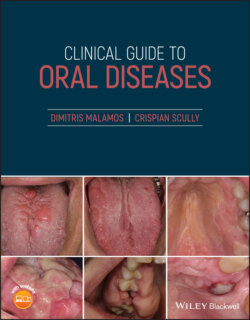Читать книгу Clinical Guide to Oral Diseases - Crispian Scully - Страница 42
Case 3.6
ОглавлениеFigure 3.6
CO: A 68‐year‐old woman presented with a diffuse skin discoloration on her neck.
HPC: This discoloration appeared two weeks ago, coming after an erythema on the sun‐exposed skin of her neck and was associated with dryness and mild pruritus.
PMH: This lady suffered from a mild rheumatoid arthritis which had being controlled with sulfasalazine and ibuprofen tablets. However, the latter seemed to cause her mild hypertension and therefore, it had been recently replaced with paracetamol. Her medical records revealed a meningioma which was removed five years ago along with a squamous cell carcinoma on her tongue, and ipsilateral lymph nodes, which were also removed two months ago. Additionally, the patient had undergone a course of chemo‐ and radiotherapy which had just been completed on the examination day. She has no other serious skin, hormone, or allergy problems and was an ex‐smoker but not a drinker.
OE: Clinical examination revealed a diffuse brown discoloration on her neck extending from the area below the mandible to the suprasternal notch. The pigmentation is darker in the middle of the neck, near the surgical incision, but fades away at the periphery (Figure 3.6); it is currently associated with mild pruritus caused by her skin dryness.
Q1 What is the possible cause of her neck pigmentation?
1 Melasma
2 Drug‐induced pigmentation
3 Solar pigmentation
4 Addison's disease
5 Radiation‐induced pigmentation
Answers:
1 No
2 No
3 No
4 No
5 The radiotherapy for head and neck cancers creates severe side effects, among them an hyper pigmentation as it seems to activate rather than to destroy melanocytes as obviously seen in this woman's facial and neck skin. This pigmentation begins as a dispersed erythema which finally, within the next one or two weeks, changes to a brown pigmentation that persists for up to four weeks after the end of the therapy.
Comments: The skin pigmentation, caused by solar rays, is not only restricted to the area of irradiation, but affects all parts of the body which are exposed to sun. Addison's disease pigmentation is seen as isolated or diffused pigmentation in the whole body, including the mouth, in contrast to melasma which is mainly restricted to the face. Hyper‐pigmentation is a phototoxic effect of various drugs, including sulfasalazine, but this was not the case here as the pigmentation only appeared during radiotherapy.
Q2 Which of the skin alterations below is/are not side effects of radiotherapy?
1 Edema
2 Desquamation
3 Ulceration
4 Rosacea
5 Skin tags
Answers:
1 No
2 No
3 No
4 Rosacea is a chronic skin disease, unrelated to irradiation and characterized by facial erythema, papules, pustules and swellings and dilation of superficial blood vessels.
5 Mucosal tags are benign growths on the skin of the neck, chest, underneath the breasts and surrounding groin. These lesions have been connected with a number of conditions such as Crohn's disease, polycystic ovary syndrome, acromegaly, and diabetes mellitus type 2, but not with radiation.
Comments: Among the side effects of radiation, erythema and edema are common and usually appear after the first two weeks of treatment, while ulcerations and atrophy are observed at the end of radiotherapy.
Q3 Which of the chemotherapeutic agents below cause increased facial pigmentation?
1 5‐fluorouracil
2 Cyclophosphamide
3 Dasatinib (tyrosine kinase inhibitor)
4 Melphalan
5 Bleomycin
Answers:
1 5‐Fluorouracil is widely used against carcinomas of the skin, oral mucosa, esophagus, stomach, pancreas, breast, and cervix by blocking the action of thymidylate synthase and DNA synthesis and stimulates the production of melanin.
2 Cyclophosphamide is used as a chemotherapeutic agent for lymphoma multiple myelomas, ovarian and breast carcinomas, sarcomas as well as neuroblastomas, as an alkylating agent which blocks DNA and RNA synthesis but increases pigmentation.
3 No
4 Melphalan induces alkylation of the DNA nucleotide guanine, thus causing alteration and inhibition of DNA and RNA synthesis in various body tumors such as multiple myelomas, malignant melanomas and ovarian cancers but associated with a number of side effects including melanosis.
5 Bleomycin is used for treatment of oral, lung, and genital carcinomas and gliomas by intercalating into DNA and reacting with ferrous ions, therefore producing free radicals capable of inducing DNA fragmentation and accumulation of neoplasmatic cells in the G2 phase of the cell cycle. Skin hyperpigmenation is rare.
Comments: Dasatinib is a tyrosine kinase inhibitor and is used for the treatment of chronic myelogenous leukemia and acute lymphoblastic leukemia with Philadelphia positive chromosome, by constraining lymphocyte‐oriented kinase (LOK) activity. As a tyrosine kinase inhibitor, it is able to cause hypopigmentation, especially in black patients who are treated with this drug for leukemia, over a long period.
